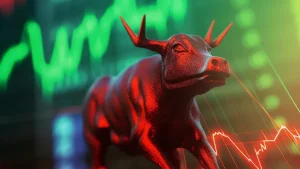- About
- Offerings
- Tools
- Pricing
- Partner
- GyanHub
- Resources

“The trend is your friend” is an idea that is analogous to the idiom “swim with the tide”. This idea is the foundation of trend trading. It simply means you buy when the market is going up and sell when the market is going down. This is a simple yet effective strategy that helped traders make money in the stock market for decades.
Now, you may think this is common sense, for who will buy when the market is falling? Or, you may question whether this strategy goes against the philosophy of “buy low and sell high”? Well, even though the idea of trend trading is simple, there’s more to it than meets the eye.

Richard Dennis was a well-known trader who achieved significant financial success in the early 1980s. He started with less than 5,000 and turned it into over 100 million. Wilhelm Eckhardt, Dennis’ partner, thought Dennis’ success was solely due to a unique talent. Dennis objected. Dennis followed a set of guidelines while trading. He believed anyone could become a profitable trader if they learned and adhered to his procedures. This is the turtle trading strategy. Let’s explore what turtle trading is.

A 200-day moving average (200-DMA) is critical data for stock prices . Which represents the moving average with a time duration of 200 days. Through this indicator, you can understand multiple things that help traders and analysts analyze market trends.
In the 200-day SMA, you can identify a support level when the price is above the moving average or a resistance level as the price goes below it. It’s just the tip of the iceberg, to know more about the 200-day moving average, go through the following article.

Investing in the stock market can be a great way to build wealth, but it’s important to understand the various terms and techniques that go along with it. One of the most important concepts among these terms & techniques is known as “pullback”.
Pullback refers to a decline or decrease in stock prices after an extended period of growth. The pullback trading strategy can have both positive and negative implications for investors, so understanding what this term means and how it works is key for any investor looking to maximize their portfolio’s potential.
A pullback is also referred to as a price correction, where the price movement moves against the current trend. It is common to see a drop in a stock’s price in the stock chart from a recent chart. As the price movement is temporary and the price will again get back on track. The pullback is quite similar to consolidation or retracement and usually occurs as the price of an asset moves at least one bar against the trend in the stock chart.

What is equity curve trading? Trading equity curves is a way to monitor and manage a trading strategy’s performance. It entails keeping track of a trading account’s equity curve over time, which displays the account’s net asset worth as it changes in response to gains and losses made using the trading technique.
The trader’s goal in equity curve trading is to maximize the equity curve’s upward trajectory while limiting drawdowns or losses. The trader may implement a number of risk management strategies, including establishing stop-loss orders or position sizing guidelines, to accomplish this.
The performance of the trading strategy can also be assessed using the equity curve, and any necessary adjustments can be made. The trader may need to re-evaluate the approach and make adjustments to increase profitability, for instance, if the equity curve reveals a protracted period of losses or stagnation.
Equity curves provide traders with a handy tool for managing the effectiveness of their trading tactics over time. Traders can attempt to avoid losses and maximize profits by concentrating on the equity curve, which will ultimately result in more profitable trading outcomes.

The buying and selling of a firm’s shares or stocks that are listed on the stock exchange are referred to as equity trading in the stock market. A company’s share or equity is a financial asset that signifies ownership in a business. These shares are available for purchase by investors through brokers or online trading platforms, and they can choose to hold them for a short or long time. Continue reading to learn : What is equity in trading?

Traders and technical analysts all over the world refer to Fibonacci retracements while placing their trades. A Fibonacci retracement is based on the Fibonacci series, a sequence where each number is the sum of its two preceding numbers.
The most commonly known sequence is 0, 1, 2, 3, 5, 8, 13, 21, 34, 55, 89, 144, 233 and so on.

According to the stock trading mechanism, in the era of physical trading, the stocks are physically auctioned in the market. Traders had to take careful measures, and the margin for error was huge. Many scams and stock manipulation led to chaos and huge losses in the stock market. In that era, trading was only done by the rich and famous and the common people looked as if it was out of their league.

The technical indicator known as RSI, or relative strength index, is used in financial trading to gauge the strength and momentum of a security’s price. J. Welles Wilder created RSI in the late 1970s. But what is RSI meaning? How does it work? Let’s see.

Contrary to chasing the hottest trending stocks in the market, value investing focuses on investing in stocks that are underappreciated by the market at large. If we had to get more technical, value investing is the strategy of investing in stocks trading at a price below their intrinsic value. However, to keep it simple, think of value investing as the basic idea of investing in deeply discounted stocks. That said, value investing is much more nuanced than just investing in stocks with a low PE ratio.

The simple moving average is a moving average. It is produced by averaging prices or values across a set number of days or intervals. It is utilised in the financial sector as a technical indicator. The SMA line, formed by the average or SMA values displayed in a chart of asset prices, moves when fresh average values are drawn. Trading professionals may examine price changes and spot patterns and choose appropriate entry and exit points by applying SMA to asset prices based on a chosen range.

Many experienced traders say that the stiffest challenge you’ll face in becoming a trader is conquering your own psyche!!